
Today, the ANZ Bank’s CEO of Australian operations, Phil Chronican, gave a superb speech on the state of the Australian housing market to the American Chamber of Commerce in Australia (AmCham). In his speech, Mr Chronican touched on a number of important issues, including: inadequate housing supply; negative gearing; housing’s poor investment fundamentals; and the folly of using demand-side policies to improve housing affordability.
Of course there are some significant ommissions from the speech too, including the role of easy credit in inflating Australian home values, as well as an absence of discussion on risks facing the Australian economy and housing market, such as a hard landing in China or GFC 2.0. But overall, it’s a well-balanced speech that is free from spin and bank propaganda.
Below is an extract of Mr Chronican’s speech, separated-out by sub-headings that I have added. I have also included some commentary and data for extra context.
Introduction:
Today I’d like to share a few of my own thoughts to the discussion about what we’re seeing in the Australian housing market and why… and what we might see in year ahead…
Australian house prices have risen significantly over the last 30 years, well in excess of either inflation or incomes growth…
In recent times, we’ve seen price growth ease in 2010 and flatten in 2011 and in the last quarter marginally decline…
This has been the result of a range of things including:
- The removal of the first home owners grant
- Rising interest rates
- A re-tightening of foreign investment rules; and
- Slowing population growth – with a near halving of net-overseas migration.
Prices, which are still very high in a historical sense, are also having an impact, particularly on affordability for new buyers.
We’re seeing this play out in reduced demand such as lower auction clearance rates.
This decline in demand is impacting the banks too with credit growth for housing at rates lower than we have seen for 30 years…
In the current environment, people and businesses are lending less and saving more.
We’re also likely to see further increases in interest rates in the coming months, as the RBA looks to manage rising inflationary pressures in the economy…
It is house prices that remain the flashpoint in the market.
Housing affordability:
The Economist magazine sparked enormous debate recently by publishing the results of a survey that estimated Australian houses are ”overvalued” by 56 per cent – the highest in the world.
It did so using a historical ratio of rents to house prices. This put Australian housing comfortably above the second-highest, that of Hong Kong.
The survey result was contentious as everybody has a different view of what constitutes the appropriate benchmark. Measuring by rental yields assesses housing as an investment, measuring against incomes looks to affordability or you can simply look at the price of a similar piece of real estate in two locations and compare.
However, looking at where average house prices have gone over the last 25 years – from $100,000 to above well above $500,000, its reasonable to say prices are high.
The question of affordability is a little more complex as you need to take into account not just prices but interest rates and incomes.
Some argue that the decline in interest rates somehow offsets the higher prices, although this relies on a convenient start date for the comparison.However if you look at the last twenty or so years we have seen incomes rise and interest rates fall. This means the average person’s effective purchasing power is much greater than it was.
Trying to justify house prices by looking at incomes, affordability – however you choose to measure it – and relative yields seems to me to miss a large element of the debate.
After last year’s infamous investor presentation by CBA, which misinterpreted Australia’s house-price-to-income ratio and painted an overly rosy picture of the Australian housing market, as well as previous reports by the ANZ claiming that Australian house prices are not overvalued, it’s nice to hear Mr Chronican admit that home prices are high.
Back to the article.
Supply-side squeeze:
If we were discussing car prices or the price of plasma TVs we wouldn’t be seeking to rationalise price increases as being due to interest rate falls!
The missing part of the house price equation is the supply side.For all intents and purposes, a house is a consumer good.
Everything in a house, including the materials and labour embedded in it, are tradable commodities.
As such, there’s no reason why they should cost anymore in Australia than they do elsewhere, for anything other than short periods.
Of course you need somewhere to put a house, so it is the value of residential land that is the only real driver of house price differentials.
Prices for inner-city residential apartments in Australia look similar to those in Hong Kong and Singapore. Does that mean we face the same issues regarding the supply of land for housing?
Obviously when you look at Australian cities, there are far greater opportunities available for medium to high density living in inner-city areas or for lower density living on available land on city fringes than there are in Hong Kong or Singapore.
People are paying a price for land that is many multiples of its alternative use and many multiples of what people in the US and Europe are paying for residential land in similar sized cities.
Absolutely. Australia’s rationed land supply is a key reason why Australia has topped the latest Demographia International Housing Affordability Survey, holding 9 of the 20 most unaffordable housing markets out of the six countries surveyed (see below chart).
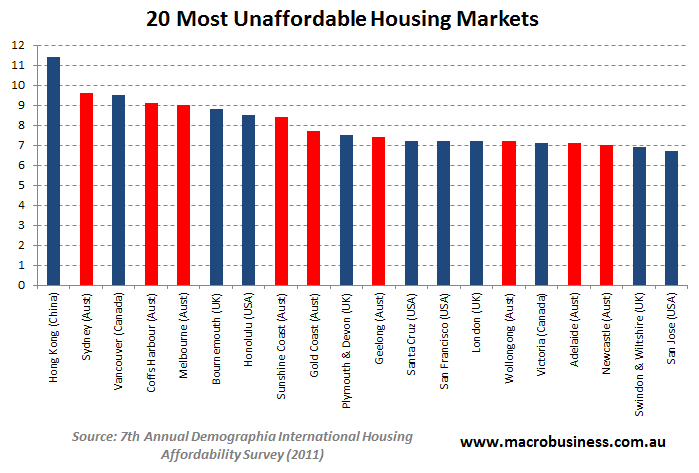
It also explains why Australian fringe land prices have risen so strongly at the same time as block sizes have shrunk in size (see below chart).
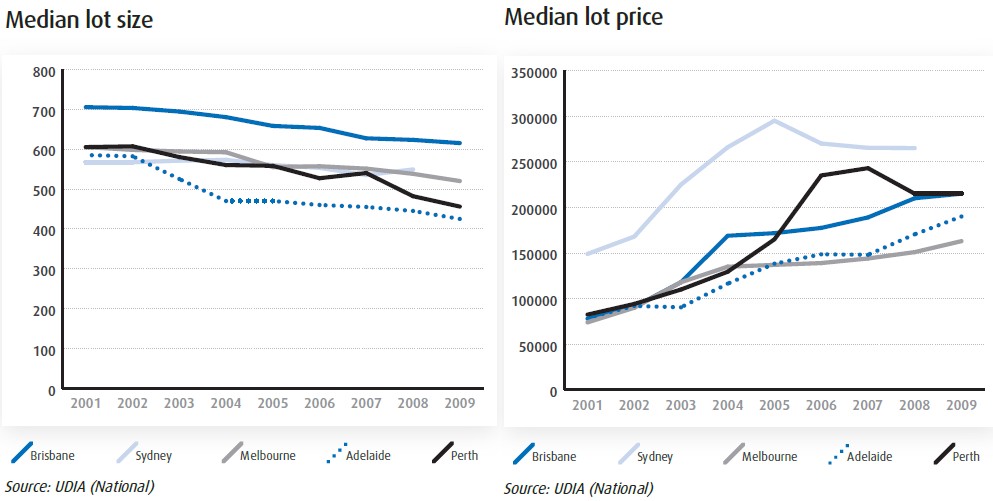
And residential land values to GDP have risen so strongly:
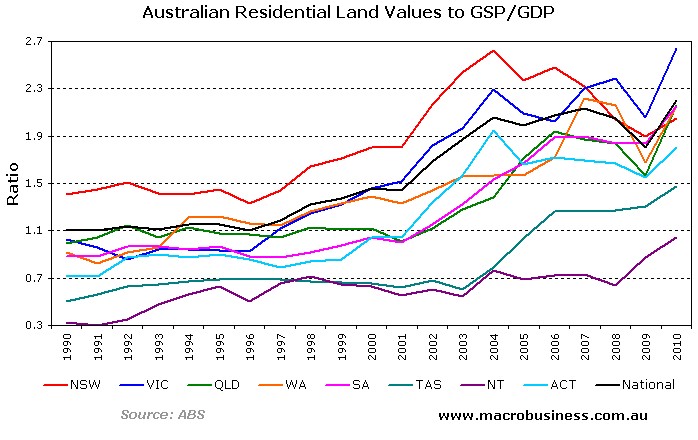
Back to the article.
To an economist – and as you know that’s where I started out so you’ll have to forgive my indulgence – the issue is obvious: constraints on the supply-side have artificially steepened the supply curve for residential housing which has meant that as demand has increased it has been directly translated into price increases rather than additional supply.
In most industries, if demand increases, supply responds. Again using the car industry, if demand for new cars increases, car manufacturers supply more cars for sale and prices remain relatively stable.
In housing, we don’t see the same response in terms of demand bringing on an adequate level of supply.
In fact, under the status quo, the Australian housing market is clearly losing the battle to keep demand and supply in check.
The supply of housing will become even more critical in the coming years as Australia lifts its intake of skilled migrants to help fill shortages in the labour market in order to support our growing economy – as was foreshadowed in the recent Federal Budget.
Responsibility for many of the controls relating to the supply of residential land and housing rests with governments at the federal, state and local levels. They include:
- Land release and zoning
- Planning and building approval processes
- Infrastructure planning and costs, including development levies
- Existing transport infrastructure
The Productivity Commission Inquiry on First Home Ownership in 2003-04 found governments have an important role to play in facilitating efficient housing outcomes.
And we’ve seen what can happen when they get it wrong in the case of the first home owners grant. In practice, these grants were capitalised against house prices so quickly they didn’t so much benefit first home buyers but rather people selling to first home buyers.
We saw last month the Federal Government launch its National Urban Policy – Our Cities, Our Future – which put supply issues and affordability issues under the spotlight…
For housing at the lower end of the market, on the fringes of metropolitan areas, infrastructure planning and costs have been a major disincentive to build new housing.
Public transport from outer suburbs in most Australian cities is generally of fairly low quality, limiting the distance which people can productively live from the city centres
[And] large proportions of the costs of new houses are absorbed by local, state and federal government taxes and charges. This lowers the return on investment for developers and creates greater risk for their projects.
The supply of housing is further influenced by the large proportion of government revenue that is based on property values. For example:
- Capital gains tax at the federal level
- Stamp duties at the state level
- Property rates at the local level
As such there is a financial disincentive for governments to make major changes.
As a result of these kinds of issues, we’ve seen the level of new building approvals trail off since 2006.
If we’re going to continue to be a stable, growing country and we don’t want housing to become more unaffordable, the supply side issues need to be addressed.
We have seen increases in land being released in some cities, such as Melbourne in the last 12 months, which is encouraging – however more needs to be done.
We need reform back on the agenda to address supply side issues – I’ll come back to this point later on.
Certainly, the responsiveness of Australia’s housing supply to booming demand has been disappointing. Over the past decade, new housing construction has more or less flat-lined in most states despite rapidly rising prices. The exceptions are New South Wales, where construction levels have been falling, and Victoria, where construction levels bounced from 2008 (see below chart).
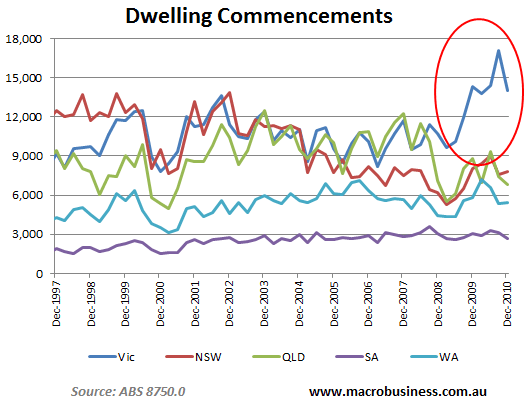
In a well-functioning housing market that was free of supply constraints, construction levels would have risen strongly after prices began rising in 1998.
Back to the article.
Poor investment fundamentals:
I want to now talk about housing as a national obsession and, perhaps controversially, lift the veil on it as an investment.
Australian’s have a strong affinity with property as an investment… as well as a place to eat and sleep.
As a nation, we hold a significant proportion of our wealth in property. Of total household wealth in Australia, we hold around 60% in real estate. [Whereas] in the US they hold around 25%.
There’s no doubt the capital gains made by most people buying, selling or investing in property over the last 15 to 20 years has added a new dimension to the Great Aussie Dream. It has created an unsustainable perception of housing as an attractive investment vehicle.
As humans, we are innately emotional beings. As such, our investments decisions are not always completely rational.
So let’s take a clinical look at the merits of property as an investment option.
On the whole, any investment should be judged by the total cost versus the total expected return and the risks involved.
With housing you have:
- Significant upfront costs relative to other investments, such as stamp duty, other state fees and legal costs.
- The cost of capital improvements and maintenance.
- Risks in terms of what happens around your property such as being built out or re-zoned. You could look at this as being the lack of diversification achievable in housing as opposed to financial assets.
- Risks in terms of market movements in prices and interest rates.
- Rental yields at roughly 3.5% gross, before outgoings, depreciation and any periods without tenants. Plus the costs and inconvenience of finding tenants and collecting the rents on time.
- And when you come to sell you have costs such as advertising and agents’ commissions plus the uncertainty of not knowing how long it will take to sell. In some parts of Australia houses are remaining on the market for six to nine months on average.
The only way you could make sense of housing as an investment is if the capital gains were sufficiently material to offset these disadvantages.
While I expect prices to hold at near current levels, and later continue to rise in line with growth in incomes, we’re not likely to see them double and re-double any time soon.The major structural changes that occurred in the 1990s, such as the RBA’s more assertive management of inflation and interest rates and the explosion in our access to credit, are not about to be repeated.
So with this in mind, if you compare housing to any other form of investment it looks weak on most criteria…
Housing does need to be owned by someone, but that doesn’t support an individual having the majority of their net wealth tied up in one or two individual properties.
It is an excessive concentration risk in an investment with poor income returns and high transaction costs – particularly in the slower growth environment we are now in.
Get it. Housing is currently a very poor investment, offering pathetically low yields, high transaction costs, and little prospect of capital growth. Of course, most of us knew these facts already. But it’s great to get such candor from a bank CEO.
Back to the article.
Future direction:
So where is the market headed?
Much of the more energised commentary has focused on the Australian housing market as a bubble waiting to burst. I do not subscribe to that view.
Housing markets collapse when demand collapses. It is the same steep supply curve working in reverse. The worst affected areas of the US market were those where overbuilding was the greatest. Similarly the most difficult market in Australia is also where oversupply is present.
That is not the case for Australia’s capital city housing markets. Continued population growth – including the current lower rates of net immigration – means we continue to have strong demand for new housing.
I don’t entirely agree with Mr Chronican on these points. Unresponsive housing supply makes home prices more volatile, resulting in boom/bust cycles as demand rises and then falls. This relationship is clearly evident in the UK housing market, which has experienced four asset boom/busts over the past 40 years as a result of its highly restricted supply (see below chart). The rate of new home construction in the UK has also been well below that of Australia.
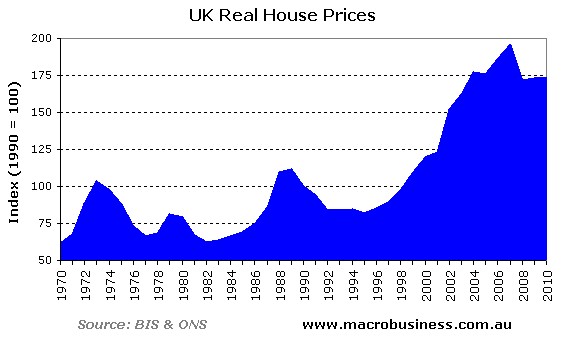
Home prices in supply-restricted California, which has also experienced lower rates of home construction than Australia, have also been highly volatile:
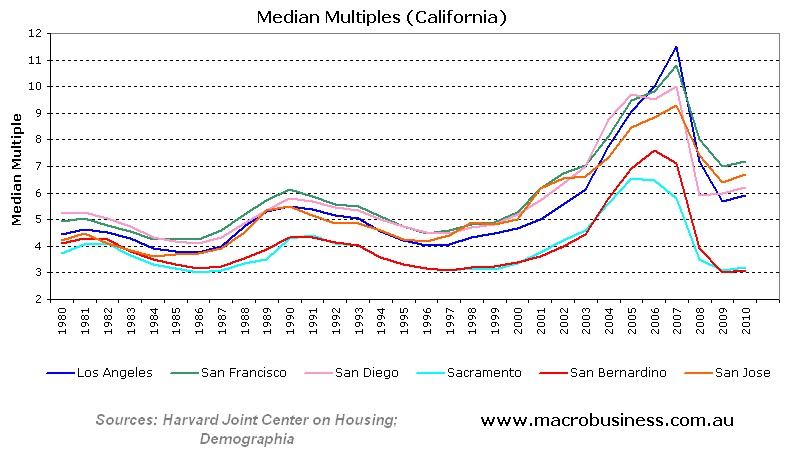
The point is, although Australia’s unresponsive housing supply explains part of the run-up in Australian home prices, should demand ever fall, say through a contraction of credit (credit shock) or a sharp fall in commodity prices (income shock), then home prices would likely drop sharply.
Mr Chronican seems to believe that housing demand will stay elevated indefinitely on the back of continued solid population growth. How realistic is this? Sure, Australia hasn’t experienced a technical recession in 20 years, but we have experienced several shocks that, in the absence of demand-side stimulus, would have made the history of Australian house prices look much more like the UK. Mr Chronican’s already noted skepticism of these measures is part of a broadening recognition that such schemes should stop. If that’s the case, and the FHOG doesn’t return, the next shock will be telling.
Back to the article.
For the first time in more than 40 years, we have seen the number of people per household in Australia increase over the last two years. Years of smaller families, children leaving home, retirees living longer and sometimes alone for long periods, family breakdown – are now being reversed as subdued supply and the affordability limits of high prices finally bite.
The weakness in prices is likely to continue. If interest rates continue to rise and the price of other essential services rise, we are likely to be in for a sustained period of low house price growth as a function of affordability, but with latent demand ready to pounce if prices come back to more reasonable levels.
What does all this mean for home buyers?
It means they need to assess housing on its merits. They need to ask themselves:
- Is it where I want to live?Will I be happy with it for seven to 10 years?
- Can I afford it?
- If there were no capital gains for the foreseeable future would I still be happy to buy it rather than rent?
For investors it means they need to rationally assess questions such as:
- Is the yield really sensible?
- Will the negative carry – if there is one – be worth it?
- What sort of capital gain do I need to achieve to make sense of the investment after all the costs?
- Is this realistic in the new economic paradigm?
And for banks it means there is even more need for a disciplined approach to managing risks:
- Are our lending practices as prudent as they should be?
- If we can’t rely on capital gains to cover high loan-to-value-ratios will the loans look as good?
- Are investors really able to withstand extended periods of negative cash flows?
Solutions for housing affordability:
Before I close, I want to comeback to the supply side issues in the housing market and my comments about the need to get reform back on the agenda.
Most people would agree that issues concerning affordability have got to a point that letting market forces attend to them is not going to work. In fact it would lead us into a worse position.What we need is a real, ideally shared, political commitment for reform and the discipline to see a long term plan through to completion. A broader public discussion about the issues should underpin this.
As part of this plan we need to look at:
- How we free up more affordable land and housing on our urban fringes for first time buyers supported by public infrastructure which supports communities and broader urban planning objectives, including social demands for more public space.
- How we encourage medium and high density development in areas where demand is high and existing infrastructure can support further development.
We also need to refrain from pursuing short-term policies that add to demand side pressures. If we really want to help people into homes, we need to address the supply side issues, not add to the demand pressures that drive prices up.
And governments might want to look at whether the current extent of negative gearing tax breaks are fostering an unhealthy focus on housing as an investment, thereby compounding the affordability issues.
There’s no lack of challenges in the Australian housing market – be it high prices, slowing growth, affordability or what the future may hold.
And as such a central piece in our economy and way of life, the housing market and these challenges will have an influence on us all in some shape or form.The good news is that we are facing these challenges at a convenient time, when the fundamentals of the economy are strong and supportive and there is every prospect of benign and subdued conditions ahead rather than a crash.
The benign and subdued economic conditions that Mr Chronican alludes to would require uninterrupted growth in China, Australia’s commodity prices to remain near record highs, and the global economy to avoid another financial crisis. That’s a leap-of-faith in my view.
- However if we don’t address the structural issues now, we could face a very different outcome in the face of the next major economic downturn.
We have seen in the US and UK what can happen when demand falls sharply and excess supply becomes evident…- While I am not a subscriber to the “inevitable crash” hypothesis, I do feel that we need to:
- Take a mature attitude to the state of the housing market
- Ask the question of what’s really in our best interests; and
- Remember that the primary purpose of a house is as a place to live in and raise your family, not a speculative investment
Despite some minor points of difference, these are refreshing words from one of Australia’s leading bankers.
Cheers Leith

